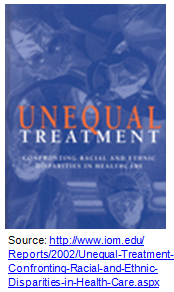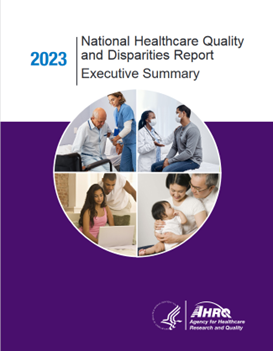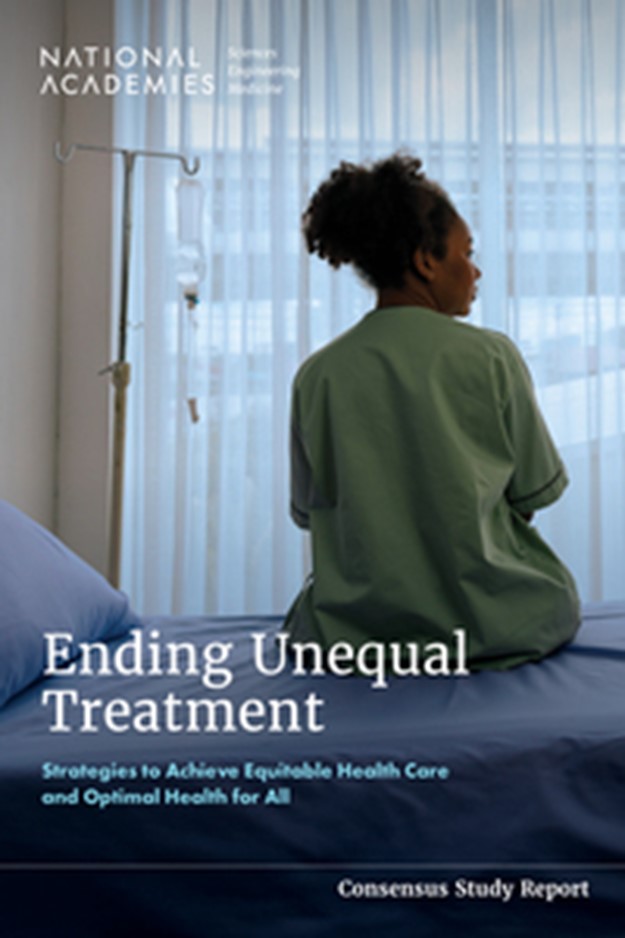Online Course
NRSG 780 - Health Promotion and Population Health
Module 5: Health Disparities / Cultural Competence
Leading Reports on Health Disparities
IOM Report on Unequal Treatment
 A landmark report on health disparities is the Institute of Medicine (IOM) report published in 2002 titled: Unequal Treatment: Confronting Racial and Ethnic Disparities in Health Care.
A landmark report on health disparities is the Institute of Medicine (IOM) report published in 2002 titled: Unequal Treatment: Confronting Racial and Ethnic Disparities in Health Care.
“Disparities in the health care delivered to racial and ethnic minorities are real and are associated with worse outcomes in many cases, which is unacceptable.”
- Alan Nelson, retired physician, former president of the American Medical Association and chair of the committee that wrote the IOM report. Martha Hill, former dean of the Johns Hopkins School of Nursing, co-chaired the committee.
The report described evidence of racial and ethnic disparities in healthcare:
- Found consistently across a wide range of disease areas and clinical services
- Present even when clinical factors, such as stage of disease presentation, co-morbidities, age, and severity of disease are taken into account
- Found across a range of clinical settings, including public and private hospitals, teaching and non-teaching hospitals, etc.
- Associated with higher mortality among minorities
The report identified potential sources of disparities in care:
- Health systems-level factors – financing (e.g., lack of insurance), structure of care; cultural and linguistic barriers
- Patient-level factors – including patient preferences, refusal of treatment, poor adherence, biological differences
- Disparities arising from the clinical encounter
AHRQ Report on National Healthcare Disparities

Since 2003, the Agency for Healthcare Research and Quality has produced the National Healthcare Quality Report and the National Healthcare Disparities Report. These reports to Congress are mandated in the Healthcare Research and Quality Act of 1999 (P.L. 106-129). Beginning with the 2014 reports, findings on health care quality and health care disparities are integrated into a single document that provides a comprehensive overview of the quality of health care received by the general U.S. population and disparities in care experienced by different racial, ethnic and socioeconomic groups. Key findings of the 2023 report focus on:
- Demographics
- Leading Health Concerns
- Social Determinants of Health
- Health Care Delivery Systems
- National Health Expenditures
- Geographic Variations in Care
- Special Emphasis Topics
- Impact of COVID-19 on the US Population
- Impact of COVID-19 on Hospitals
- Impact of COVID-19 on Ambulatory Care
- Impact of COVID-19 on Nursing Homes
- Impact of COVID-19 on Telehealthcare
If you are interested in further information, review the priorities available at: https://www.ahrq.gov/sites/default/files/wysiwyg/research/findings/nhqrdr/2023-nhqdr-es-rev.pdf
CDC Health Disparities & Inequities Reports
 Factors, environmental exposures, social determinants, and healthcare access by sex, race and ethnicity, income, education, disability status and other social characteristics.
Factors, environmental exposures, social determinants, and healthcare access by sex, race and ethnicity, income, education, disability status and other social characteristics.
CDC published its first report on Health Disparities and Inequities (CHDIR) in 2011. These reports assess health disparities and inequalities for a broad range of diseases, behavioral risk factors, environmental exposures, social determinants, and healthcare access by sex, race and ethnicity, income, education, disability status and other social characteristics. They also identify interventions that can reduce health disparities among high risk populations.
To review the CDC’s Office of Minority Health Activities, please review the Minority Health website available at https://www.cdc.gov/minority-health/index.html

In 2024 the National Academies released an updated report that concludes:
1. The nation has made little progress in advancing health care equity. Racial and ethnic inequity remains a fundamental flaw of the U.S. health care system.
2. Racial and ethnic health care inequities are driven by a complex interaction between health care and key external societal forces that serve as enablers or barriers to achieving equitable health care and optimal health. Achieving optimal health for all requires substantive changes in the larger societal forces that influence health and health care.
3. Over the past 20 years the nation has experienced profound changes in laws and policies, with implications for health care access, coverage, affordability, workforce, and the drivers of health care equity. Some changes in laws and policies have advanced health care equity significantly, while other changes have slowed down progress toward advancing this important goal.
4. A diverse health and science workforce, representative of the communities that it serves, is essential to health care equity. The nation has made little progress addressing this goal. Recent court decisions concerning diversity, equity, and inclusion are likely to further limit progress in achieving a diverse workforce.
5. Comprehensive and sustained efforts to improve health care across the continuum of care, from primary to quaternary care, including mental health care, have often been the most beneficial to minoritized populations facing the deepest inequities. In contrast, time-limited and/or incremental reforms often fall short of improving health care equity and may trigger unintended consequences that widen inequity gaps.
6. Emerging approaches to achieving health care equity show promise and are poised for increased investment, implementation, and expansion so that progress is translated into long-term improvement in outcomes. This requires leadership and definitive action to implement sustainable policies and programs that maintain and continue to advance progress in an ever-evolving health care system.
7. Continual research and evaluation are needed to measure and drive improvements in health and health care equity. Research findings need to be widely disseminated, and successful interventions need to be rapidly implemented and translated into practice and policy.
8. Accountability is essential to advancing health and health care equity. Inadequate enforcement of current laws and policies that promote equitable health care to advance health equity has hindered progress. Enhancing systems of accountability throughout the health care system, with a focus on achieving equity and optimal health, are required.”
Source: https://nap.nationalacademies.org/read/27820/chapter/2#7This website is maintained by the University of Maryland School of Nursing (UMSON) Office of Learning Technologies. The UMSON logo and all other contents of this website are the sole property of UMSON and may not be used for any purpose without prior written consent. Links to other websites do not constitute or imply an endorsement of those sites, their content, or their products and services. Please send comments, corrections, and link improvements to nrsonline@umaryland.edu.